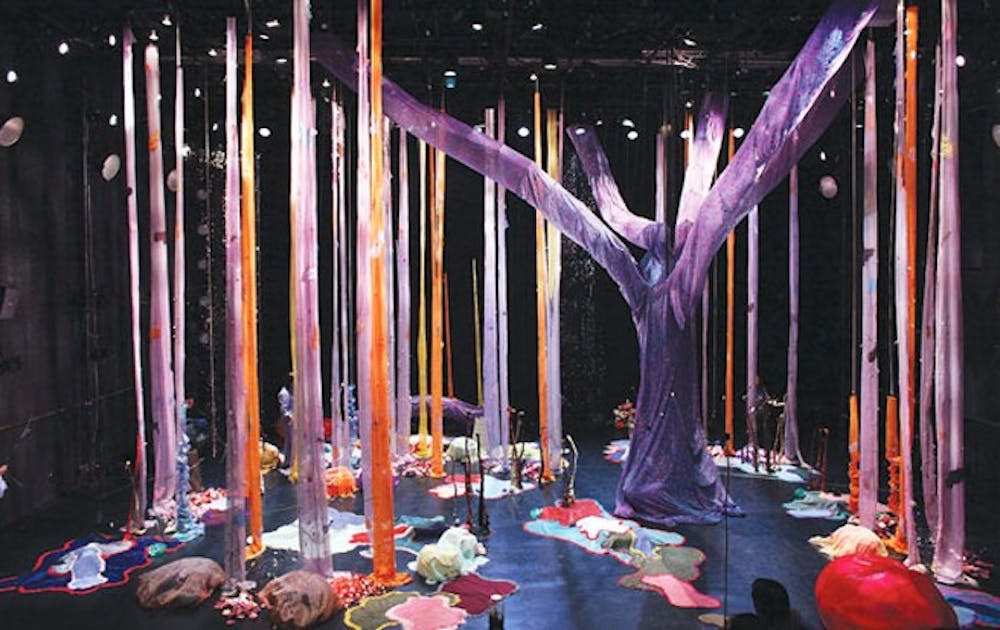If you thought one forest was enough for Duke University, think again—another will be sprouting up this weekend inside of Page Auditorium.
“How to Build a Forest” was created by PearlDamour, an interdisciplinary theater team, in collaboration with visual artist Shawn Hall. Countless elements are carefully orchestrated to create a hybrid somewhere between installation and performance. The interactive, multi-sensory experience lasts for an eight-hour period, during which time a forest of fabrics and fibers is gradually built from scratch and then dismantled entirely.
Katie Pearl and Lisa D’Amour have worked together as PearlDamour since 1997. The duo won an Off-Broadway Theater Award for their 2003 play Nita and Zita, a true story of two New Orleans showgirls, through which they met Hall, who did the set design. “It was sort of obsessively painted, with sequins everywhere,” said Pearl of Hall’s interpretation. The two appreciated her distinct visual style, and the development of “How to Build a Forest” progressed naturally.
“Once we started talking, the piece really started to take its own shape based on our mutual interests,” Hall said. “It changed the way we think as true collaborators. It’s not the ‘theater model.’ I’m not designing for them, I’m designing with them.”
The idea had evolved for two years before its debut at The Kitchen in New York City in June 2011, and will next head to Brown University in Providence, Rhode Island.
PearlDamour and Hall participated in a panel at the Nasher Museum of Art last weekend along with Megan Granda, executive director of Duke Center for Civic Engagement, and Marjorie Pearson, a Durham-based fine arts photographer. Pearson, who has taught and lectured at Duke’s Nicholas School of the Environment, focuses on the natural beauty of southern wetlands in photographs that range from the realistic to the abstract. In capturing her surroundings on film, her overlying objective is to bring attention to the disappearance of these stunning landscapes.
“Environmental arguments tend to put people on the defensive,” she said. “When faced with the idea of loss, people become paralyzed, but association with visual imagery can build bonds before words are ever spoken. Your mind becomes more open to discussion on these complex subjects.”
In its attempt to build these bonds, “How to Build a Forest” goes beyond the presentation of an appealing aesthetic.
“The way to really engage with people is to make with, not make for,” said Pearl. Attendees will have the opportunity to walk onstage and look closely at the elements of the forest, and even sit down within it, and members of the performance will occasionally venture offstage and incorporate themselves into the audience.
“There are several elements that are theater performance,” said Mao Hu, a Duke sophomore who has been working as an assistant to the directors. Rather than tell viewers to “sit there and we’ll tell you a story,” which Pearl observes as the norm in more traditional American theater, the trio have designed a truly immersive experience. They seek to “create a space, or personal relationship, before a message is delivered.” Within this theme of the nontraditional space, viewers are encouraged to come and go throughout the piece’s duration to view the forest in its many stages of development.
Attendees will be handed field guides that contain specific and detailed information about the materials that comprise the forest, including their former uses and potential toxicity. The statement is fairly clear: we, as a society, do not sufficiently consider sustainability in our acts of consumption. The artists, however, have carefully refrained from delivering one specific message through the piece.
“How do you bring someone into an experience? You can’t force them,” D’Amour said. “You have to create the circumstances so they can engage in their own way.”
Jules Odendahl-James, resident dramaturg and visiting lecturer in Theater Studies, appreciates the ambiguity of the collaboration’s meaning.
“The work is so open on its own, open to lots of ways to enter in. A particular chord is struck, but it’s not directing. It’s coming out of a very specific place, but the audience will define it and bring it to fruition,” said Odendahl-James, who first initiated the bond between Duke and “How to Build a Forest.”
“It just seemed like it must come [to Duke],” she said. “We were a place where a forest was attached to our university. It was a right space for a lot of environmental science work that was happening. This was sort of my way to connect that in a piece that would also push the boundaries in terms of what people had thought of as a ‘science play,’ something in the theater having to do with scientific research.”
“How to Build a Forest,” in its previous incarnations, has relied heavily on what Lisa D’Amour calls an “ecosystem of volunteer help and paid help.”
“This is about community involvement,” said Hall, in reference to the vast requirement of effort in the preparation and execution of the piece. The Duke community has certainly risen to this challenge. A broad range of students and faculty from a variety of academic disciplines have been working tirelessly with PearlDamour and Hall to bring the forest to life.
“It’s a model for the way theater and environmental science students could work together on something that intersected in terms of the learning component,” said D’Amour.
Recalling the ongoing “Art+” lecture series about the intersection between art and mathematics, there seems to be an exciting new movement toward interdisciplinary arts involvement on Duke’s campus, proving that creativity and reasoning are not mutually exclusive.
“How to Build a Forest” will take place on Friday, October 19 through Sunday, October 21.
Get The Chronicle straight to your inbox
Signup for our weekly newsletter. Cancel at any time.

